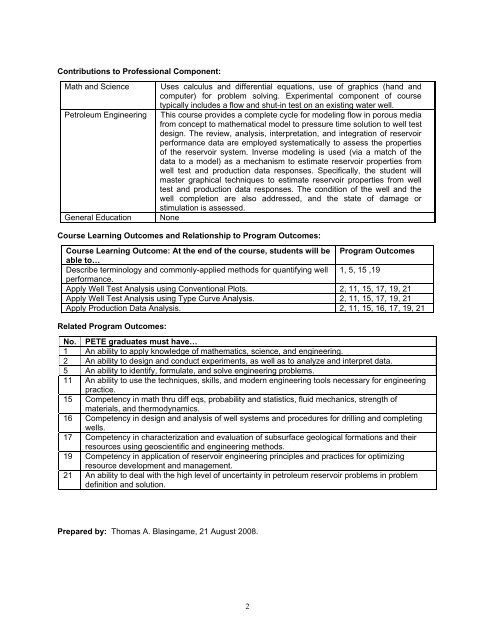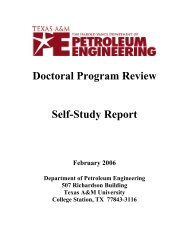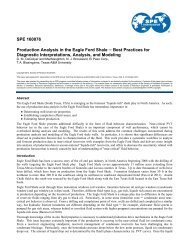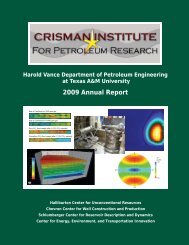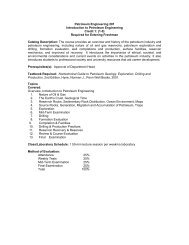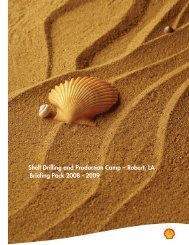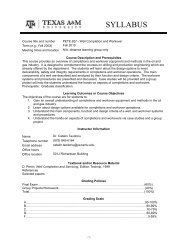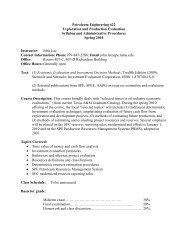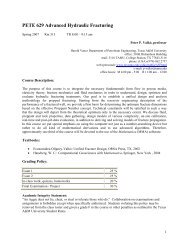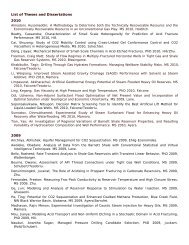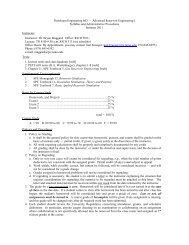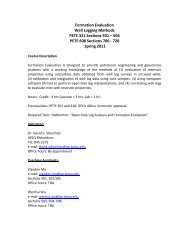Nontechnical Guide to Petroleum Geology, Exploration
Nontechnical Guide to Petroleum Geology, Exploration
Nontechnical Guide to Petroleum Geology, Exploration
Create successful ePaper yourself
Turn your PDF publications into a flip-book with our unique Google optimized e-Paper software.
Contributions <strong>to</strong> Professional Component:<br />
Math and Science<br />
<strong>Petroleum</strong> Engineering<br />
General Education<br />
Uses calculus and differential equations, use of graphics (hand and<br />
computer) for problem solving. Experimental component of course<br />
typically includes a flow and shut-in test on an existing water well.<br />
This course provides a complete cycle for modeling flow in porous media<br />
from concept <strong>to</strong> mathematical model <strong>to</strong> pressure time solution <strong>to</strong> well test<br />
design. The review, analysis, interpretation, and integration of reservoir<br />
performance data are employed systematically <strong>to</strong> assess the properties<br />
of the reservoir system. Inverse modeling is used (via a match of the<br />
data <strong>to</strong> a model) as a mechanism <strong>to</strong> estimate reservoir properties from<br />
well test and production data responses. Specifically, the student will<br />
master graphical techniques <strong>to</strong> estimate reservoir properties from well<br />
test and production data responses. The condition of the well and the<br />
well completion are also addressed, and the state of damage or<br />
stimulation is assessed.<br />
None<br />
Course Learning Outcomes and Relationship <strong>to</strong> Program Outcomes:<br />
Course Learning Outcome: At the end of the course, students will be Program Outcomes<br />
able <strong>to</strong>…<br />
Describe terminology and commonly-applied methods for quantifying well 1, 5, 15 ,19<br />
performance.<br />
Apply Well Test Analysis using Conventional Plots. 2, 11, 15, 17, 19, 21<br />
Apply Well Test Analysis using Type Curve Analysis. 2, 11, 15, 17, 19, 21<br />
Apply Production Data Analysis. 2, 11, 15, 16, 17, 19, 21<br />
Related Program Outcomes:<br />
No. PETE graduates must have…<br />
1 An ability <strong>to</strong> apply knowledge of mathematics, science, and engineering.<br />
2 An ability <strong>to</strong> design and conduct experiments, as well as <strong>to</strong> analyze and interpret data.<br />
5 An ability <strong>to</strong> identify, formulate, and solve engineering problems.<br />
11 An ability <strong>to</strong> use the techniques, skills, and modern engineering <strong>to</strong>ols necessary for engineering<br />
practice.<br />
15 Competency in math thru diff eqs, probability and statistics, fluid mechanics, strength of<br />
materials, and thermodynamics.<br />
16 Competency in design and analysis of well systems and procedures for drilling and completing<br />
wells.<br />
17 Competency in characterization and evaluation of subsurface geological formations and their<br />
resources using geoscientific and engineering methods.<br />
19 Competency in application of reservoir engineering principles and practices for optimizing<br />
resource development and management.<br />
21 An ability <strong>to</strong> deal with the high level of uncertainty in petroleum reservoir problems in problem<br />
definition and solution.<br />
Prepared by: Thomas A. Blasingame, 21 August 2008.<br />
2


